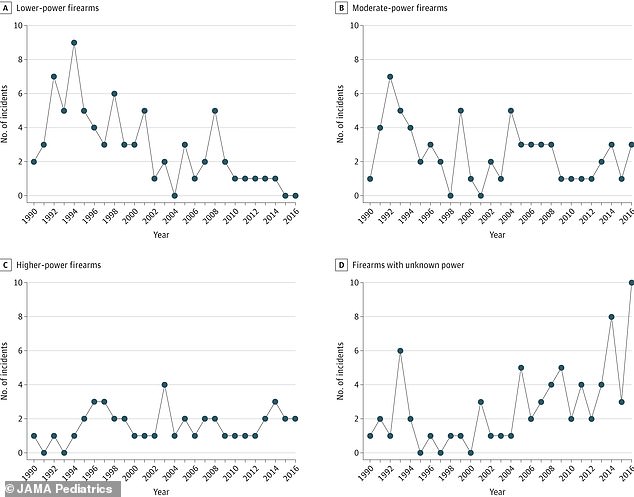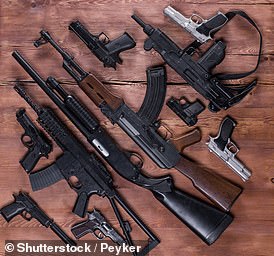Most school shootings are carried out using stolen pistols NOT high-powered machine guns, according to US study that ‘may influence gun control policy’
>
The majority of weapons used by students in school shootings between 1990 and 2016 were low- to medium-powered firearms, a new study finds.
About 77 percent of the weapons used in 253 school shootings over a 26-year period were handguns or smaller-caliber rifles, a finding that flies in the face of the common image that school shooters carry high-powered assault weapons.
While much of the public discussion about preventing firearm deaths focuses on common-sense gun control laws or technology issues, such as magazine capacity, this research points to a simple solution: safe storage.
In about 61% of cases, teens appear to have stolen these weapons. The vast majority of guns stolen were taken from family members.
“Overall, these findings underscore the important public health message regarding the safe storage of firearms, especially in households with adolescents,” the study authors wrote.
The finding comes from a team of criminology researchers at the University of South Carolina and the University of Florida, who combed through data from hundreds of school shootings over 26 years, recording the types of weapons the 262 teenage perpetrators used and how they obtained them. they.
Only about 17 percent of guns were purchased illegally.
School shootings may conjure images of an assault rifle, but most shootings committed by teens between 1990 and 2016 used smaller-caliber, low- to moderate-power weapons.
Although we might think of school shootings as mass casualty events — defined as four or more deaths — only 2.8 percent of school shootings fit this definition, and only 47 percent resulted in one or more deaths. more.
“These shootings often involved handguns, not assault rifles, and were typically rooted in interpersonal disputes, largely reflecting broader patterns of gun violence within our society,” the study authors wrote.
These results show that the stereotypical view of a mass shooter is correct only in a small percentage of cases.
“We’ll have very classic, tragic mass shootings, where someone comes out with a statement and wants to kill as many people as possible,” says Dr. Chethan Satia, pediatric surgeon and trauma director at Cohen Children’s Medical Center. and Director of the Center for Gun Violence Prevention at Northwell Health, He told CNN. He did not participate in the new study.
“You’ll also have gang-related violence, shootings that happen at school, but you have to do more with interpersonal violence and other drivers of community violence that are actually different from the things that might lead to these typical mass shootings,” Satya added.

The number of lower-powered weapons used by students in school shootings has declined since 1990, while the number of higher-powered firearms has remained stable. It is worth noting that the number of weapons of unknown power has increased steadily
The TASSS includes data on adult and youth offenders, but for the purposes of this study, the authors only used data on shooters who were 19 years of age or younger.
When examining how students obtained their guns, the study authors found that the vast majority of stolen guns came from their relatives — 82 percent.
“These findings may significantly impact gun control policy discussions, especially in advocating for safe firearm storage to reduce adolescent access to guns,” they wrote.
the Stady Featured on Monday JAMA Pediatrics.
About 98% of shooters in the study period were male, and about 58% were black. 28% were white, 9% were Latino, and about 6% came from other ethnic groups.
Most of the weapons used in these shootings were not rifles but pistols. These small arms make up about 86 percent of the weapons used by student shooters.
Interestingly, the number of lower-powered weapons used in school shootings each year decreased throughout the study period, while the number of higher-powered weapons remained constant.
For the most part, TASSS data are comprehensive. A wealth of documents fill the TASSS database, which extends to more than 90,000 pages.
However, the database has limitations.
Because it relies on public records, if the public records in question — such as obituaries, court records, media accounts, etc. — contain incomplete information, so does TASSS.
“Open sources can include ambiguous, inaccurate, and conflicting information, leading to human and other measurement errors,” the study authors wrote. “Therefore, we advise readers to treat the results with caution.”
One noteworthy inaccuracy: The number of unknown-powered weapons used in school shootings has been steadily rising each year, as shown in the graphs above.
“Although school shootings typically receive widespread media coverage, this finding suggests that the content and nature of reporting practices may have changed over time,” the study authors wrote.
“Therefore, despite widespread media coverage, the increase in online and social media posts in the 21st century has not necessarily deepened our understanding of firearms used in shootings.”
For this reason, they argue that research on school shootings will benefit from a central data source — not just media reports — in order to make the numbers more accurate in the future.
(tags for translation)dailymail

